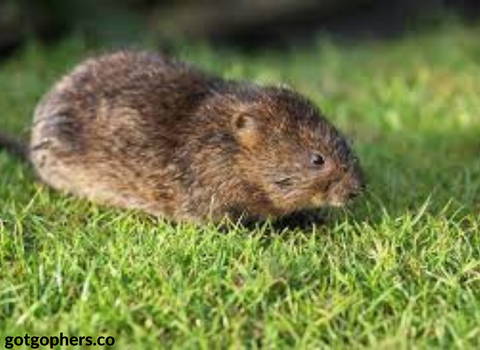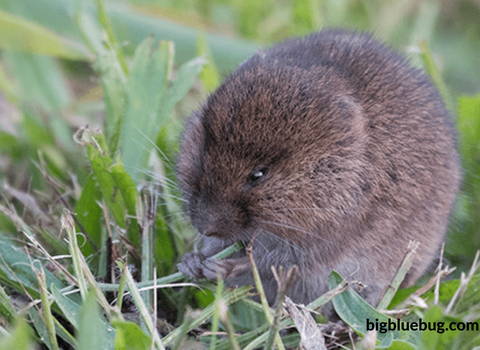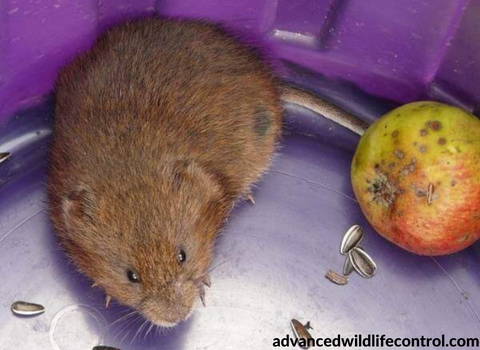How to Get Rid of Vole
Voles are among the pesky creatures that homeowners and gardeners may deal with. One of the obvious signs that voles are lurking in your garden is the snakelike tunnels.
But before you address the issue, you need to know how to identify one and then get started with getting rid of the voles. After this, you can start focusing on prevention and controlling the vole population on your property.
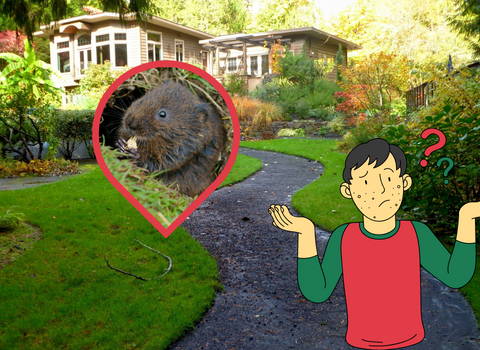
Identifying Voles from Moles
One thing that you should always remember is that voles and moles are not the same. Many confuse the two animals since both dig tunnels through the yard and are both dark-coloured small mammals. You might not notice it, but these two critters look very different when seen up close.
Voles
Voles are small and stocky rodents that almost look like field mice. At first glance, you might think of it as a mouse. They have small, rounded ears that are often hidden in their fur. These rodents also have short tails and small eyes. Most voles have thick fur that is light brown to gray.
Meadow vole or Microtus pennsylvanicus and prairie vole or Microtus ochrogaster are two of the common vole species found in North America. While prairie voles are commonly found in prairie and grassland areas, meadow voles are widely distributed. These two are very similar and ways of controlling them are usually the same.
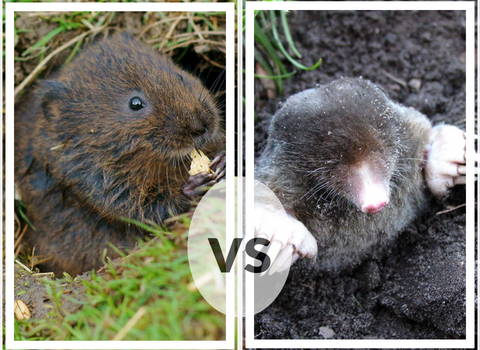
Moles
Moles are not identified as rodents. They are all mouth and nose. They use their big feet when digging.
What Do Voles Eat?
Just like most rodents that are omnivores, voles eat almost anything. However, voles are mostly on a vegetarian diet. They tend to eat blades and stems of lawn grass. This is why you will only see vole tunnels that are near the surface of your yard.
On the other hand, moles are carnivorous, their diet consists mostly of insects.
Various Ways to Get Rid of Voles
If you are starting to worry about dealing with vole infestations, then there are various ways how you get rid of voles effectively.
Trapping
Vole trapping is one of the effective methods used to reduce vole populations. You can use live traps with two openings and place them perpendicular to the nearest nesting sites like at the base of shrubs and trees or the widest vole runways.
Use peanut butter to bait traps and set them from about midday to early evening, as these are the times when voles start getting active. Reset your traps as often as needed until you get rid of voles.
If it is legal in your area, you might need to relocate the ones you caught at least 5 miles away from your property. This way, you can guarantee that you have dealt with voles permanently.
Remember that you have to be persistent to make your trapping efforts pay off. You can also consider covering the traps so that children and pets will not find them accidentally.
Aside from live traps, you can also use traditional mouse traps. If you cannot handle a live trap, mouse instant kill traps will also work. Just place it near a vole runway, while making sure that the trigger is aligned with the path that the vole will take as it uses the runway to kill voles instantly. Make sure that you also added vole bait to lure them out of hiding. Consider setting traps during autumn or late winter.
To make trapping voles more successful, you need to determine the specific area in your property that voles are using as their thoroughfare. The burrow entrances are where you need to put your live vole traps. The wider the runway the heavier the traffic. Another indicator is a runway that is heavily soiled with vole feces and urine.
Vole Repellents
There are various Thiram-based vole repellents that you can use, but these require frequent reapplication as these dissipate when it rains. In the long run, it may not work effectively to repel voles as they may get used to the smell around your yard.
Another disadvantage of using thiram is that they are not supposed to be used on or near garden plants. Most prefer using predator urines as they are found to be most displeasing to voles. Coyote and fox urines are often purchased from garden and farm centers or sometimes online.
Natural Repellents
Aside from using chemicals, you can always use natural repellents made from items that you can find in your home to control vole populations. Mix environment-friendly dish soap and chopped hot peppers with water. Put the mixture in a spray bottle and spray vole hotspots. This mixture will work in keeping voles away from your property and is safe for your plants and the environment.
Another natural repellent against boles is castor oil. Castor beans are known to be toxic to animals. They do not like the taste and smell of castor oil, which helps in repelling these critters. Just mix castor oil with water then spray it around areas or plants to protect them from vole damage.
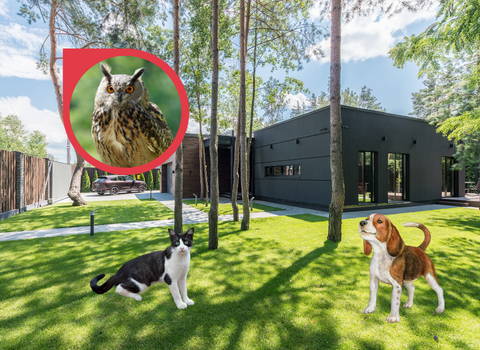
Deterring Voles Using Gravel and Fences
One way to deter voles naturally is by using wire mesh garden fencing or hardware cloth that you can wrap around the base of young trees during winter. This will protect young trees from voles gnawing their bark.
You can also place garden fencing around garden plants to keep the roots protected from voles. See to it that all fencing is buried to at least 10 inches below the ground surface to prevent voles and other burrowing animals to access plants underneath.
Also, voles do not like going through sharp gravel. If you want to plant bulbs or perennials, adding a gritty layer like sharp gravel or perlite on the side of the hole and in the bottom will protect the plants from these rodents. Planting garlic on the garden beds will also help in repelling them as voles hate the scent as well.
Natural Predators
Having natural predators of voles within your property is a big help in dealing with your vole problem. Unlike foxes and coyotes that prey on voles but you would not want to be around your home, owls are great predators that you should encourage nesting in your property.
To attract owls to nest on your property, you need to mount owl nest boxes in any tree on your property. You can get premade ones or build your own, whichever is convenient for you.
Though owls may not get rid of voles entirely, they will help reduce the vole population. You can also consider having outdoor dogs and cats that are specialized ratters. However, you cannot rely too much on cats as they might not bother going after these rodents staying underground most of the time.
Should You Consider Trying Extermination?
As much as possible, you may want to avoid extermination. The use of vole poisons may help control vole numbers, but the toxins present may pose a health risk to your children, pets, as well as other wildlife.
If in case you have used all other methods to achieve vole control and your only option left is extermination to control severe vole infestations, it is highly recommended that you use products with Warfarin. Controlling large vole populations through the use of Warfarin is the safest and most effective poison-baiting method. It is a slow-acting anticoagulant that prevents blood clotting that will slowly lead to death.
Before you turn to this method and administer the treatment on your own, it is recommended that you consult an integrated pest management specialist. This way, you will get an idea of the most effective and safest outcome from using this method to get rid of voles.
Causes of Vole Infestations
You may be one of those homeowners who are wondering how your yard attracted voles. If rats and mice seek shelter inside buildings, voles do not. During mild but snowy wintertime, they appear in more numbers in landscaped areas.
You will start noticing the vole damage on your property once the vole numbers peak. This occurs cyclically in the span of 3 to 5 years. Female voles can produce 15 to 50 young annually. They live for about a year. Their nests are usually found in grassy clumps just above the tunnels. Sometimes their tunnels are extending a few inches underground.
Ways to Prevent Vole Damage
One way to achieve vole control is making your yard or property inhabitable to voles. There are many ways to prevent vole infestation and keep their numbers down.
Voles love heavy and dense vegetative covers, meadows, and weeds. These provide them with nesting materials and protect them from predators. Make sure to cut back brush, weed, mow, and make your yard as clean as possible.
Get rid of wood piles near trees, shrubs, and your garden as these can turn into their hiding places.
Always keep bushes trimmed and lawn mowed up from the ground.
Try not to put dense mulch too close to shrubs and trees.
Keep the base of shrubs and trees free from snow. To protect young trees, wrap the lower trunk with a snow cover, small-grade hardware cloth, or any chew-proof material.
If you have bird feeders, you might want to remove them or always keep the ground clean to lower the vole number.
Make use of these tips to start controlling the presence of voles and prevent them from damaging your property.


